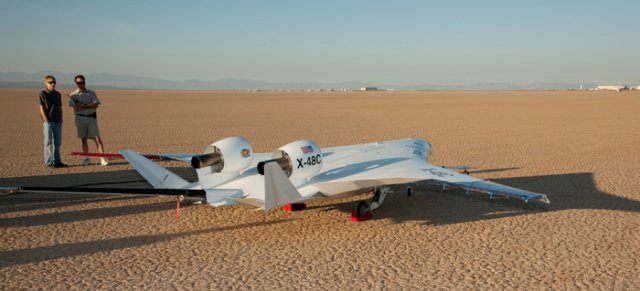The Boeing X-48C Blended Wing Body unmanned research aircraft took to the skies on its first-ever flight at 7:56 a.m. Pacific Time on August 7 from NASA’s Dryden Flight Research Center at Edwards Air Force Base in California. The aircraft climbed to an altitude of 5,500 feet before landing 9 minutes later.
The aircraft, designed by the Boeing Co. and built by Cranfield Aerospace Ltd. of the United Kingdom, is flying again in partnership with NASA. The new X-48C model, which was formerly the X-48B Blended Wing Body aircraft, was modified to evaluate the low-speed stability and control of a low-noise version of a notional, future Hybrid Wing Body (HWB) aircraft design. The HWB design stems from concept studies being conducted by NASA’s Environmentally Responsible Aviation project of future potential aircraft designs 20 years from now.
“We are thrilled to get back in the air to start collecting data in this low-noise configuration,” said Heather Maliska, X-48C Project Manager at NASA’s Dryden Flight Research Center. “Our dedicated team has worked hard to get the X-48C off the ground for this first flight and we are excited to learn about the stability and control characteristics of this low-noise configuration of the Blended Wing Body.”
Primary changes to the C-model from the B-model, which flew 92 flights at NASA Dryden between 2007 and 2010, were geared to transforming it to an airframe noise-shielding configuration. External modifications included relocating the wingtip winglets inboard next to the engines, effectively turning them into twin tails. The aft deck of the aircraft was also extended about two feet to the rear. Finally, the project team replaced the X-48B’s three 50-pound-thrust jet engines with two 89-pound-thrust engines.
Because handling qualities of the X-48C will be different than those of the X-48B, the project team developed flight control system software modifications, including flight control limiters to keep the airplane flying within a safe flight envelope. This will enable a stronger and safer prototype flight control system suitable for future full-scale commercial hybrid or blended wing aircraft.
The X-48C is a scale model of a heavy-lift, subsonic vehicle that forgoes the conventional tube-and-wing airplane design in favor of a triangular aircraft that effectively merges the vehicle’s wing and body. Boeing and NASA believe the BWB concept offers the potential over the long-term of significantly greater fuel efficiency and reduced noise.
With a 21-foot wingspan and a weight of 500 pounds, the X-48C is a modified version of the X-48B aircraft, which flew 92 times at NASA Dryden between 2007 and 2010. The X-48C is configured with two 89-pound thrust turbojet engines, instead of three 50-pound thrust engines on the B-model; and wingtip winglets have been relocated inboard next to the engines on the C-model, effectively turning them into twin tails. The aft deck also was extended about 2 feet at the rear. The vehicle has an estimated top speed of about 140 miles per hour and a maximum altitude of 10,000 feet.
The X-48B’s flight test programme proved that a BWB aircraft can be controlled as effectively as a conventional tube-and-wing aircraft during takeoffs and landings, as well as in other low-speed segments of the flight regime. “With the X-48C, we will be evaluating the impact of noise shielding concepts on low-speed flight characteristics,” said Bob Liebeck, a Boeing Senior Technical Fellow and the company’s BWB program manager.
“We are very pleased to begin flight tests of the X-48C,” said Mike Kisska, Boeing X-48C project manager. “Working with NASA, we’ve successfully passed another milestone in our work to explore and validate the aerodynamic characteristics and efficiencies of the blended wing body concept.”
Additionally, the upcoming flight experiments with the X-48C will help researchers further develop methods to validate the design’s aerodynamics and control laws, including a goal of reducing aerodynamic drag through engine yaw control tests.
During the planned second block of flight testing this fall, NASA will test engine yaw control software incorporated in the X-48C’s flight computer. This research will use asymmetric engine thrust to create yaw, or nose left or right movements, for trim and for relatively slow maneuvers.
NASA’s Aeronautics Research Mission Directorate and Boeing are funding the X-48 technology demonstration research effort, which supports NASA’s goals of reduced fuel burn, emissions and noise.
The X-48C retains most dimensions of the B-model, with a wingspan just longer than 20 feet, and a weight of about 500 pounds. The aircraft has an estimated top speed of about 140 mph, and a maximum altitude of 10,000 feet.
The Air Force Research Laboratory, Dayton, Ohio, is also a member of the project team.
Photo: NASA
Source: YouTube/ Press Release

